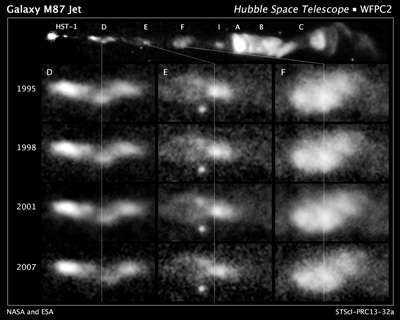Astronomers use Hubble images for movies featuring space slinky

(Phys.org) —Astronomers have assembled, from more than 13 years of observations from NASA's Hubble Space Telescope, a series of time-lapse movies showing a jet of superheated gas—5,000 light-years long—as it is ejected from a supermassive black hole.
The movies promise to give astronomers a better understanding of how black holes shape galaxy evolution.
"Central, supermassive black holes are a key component in all big galaxies," said Eileen T. Meyer of the Space Telescope Science Institute in Baltimore, Md. "Most of these black holes are believed to have gone through an active phase, and black-hole powered jets from this active phase play a key role in the evolution of galaxies. By studying the details of this process in the nearest galaxy with an optical jet, we can hope to learn more about galaxy formation and black hole physics in general."
The research team spent eight months analyzing 400 observations from Hubble's Wide Field Planetary Camera 2 and Advanced Camera for Surveys. The observations, taken from 1995 to 2008, are of a black hole sitting in the center of a giant galaxy dubbed M87.
"We analyzed several years' worth of Hubble data of a relatively nearby spiraling jet of plasma emitted from a black hole, which allowed us to see lots of details," Meyer said. "The only reason you see the distant jet in motion is because it is traveling very fast."
Meyer found evidence that suggests the jet's spiral motion is created by a helix-shaped magnetic field surrounding the black hole. In the outer part of the M87 jet, for example, one bright gas clump, called knot B, appears to zigzag, as if it were moving along a spiral path. Several other gas clumps along the jet also appear to loop around an invisible structure.
M87 resides at the center of the neighboring Virgo cluster of roughly 2,000 galaxies, located 50 million light years away. The galaxy's monster black hole is several billion times more massive than our sun.
The Hubble data also provided information on why the M87 jet is composed of a long string of gas blobs, which appear to brighten and dim over time.
"The jet structure is very clumpy. Is this a ballistic effect, like cannonballs fired sequentially from a cannon?" Meyer asked, "or, are there some particularly interesting physics going on, such as a shock that is magnetically driven?"
Meyer's team found evidence for both scenarios. "We found things that move quickly," Meyer said. "We found things that move slowly. And, we found things that are stationary. This study shows us that the clumps are very dynamic sources."
It is too soon to tell whether all black-hole-powered jets behave like the one in M87, which is why Meyer plans to use Hubble to study three more jets. "It's always dangerous to have exactly one example because it could be a strange outlier," Meyer said. "The M87 black hole is justification for looking at more jets."
The team's results appeared Aug. 22 in the online issue of The Astrophysical Journal Letters.
More information: dx.doi.org/10.1088/2041-8205/774/2/L21
Journal information: Astrophysical Journal Letters
Provided by NASA




















